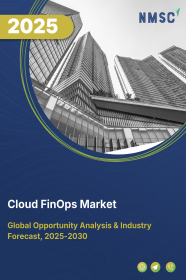
Cloud Sustainability Market by Deployment Mode (Public, Private, and Hybrid Cloud), by Service Mode (Infrastructure as a Service (IaaS), Platform as a Service (PaaS), and Software as a Service (SaaS)), by Organization Size (Small and Medium-Sized Enterprises (SMEs) and Large Enterprises), by Application (Cloud Data Centre, Cloud Storage, and Others), and by End-User (Banking, Financial Services, and Insurance (BFSI), and Others) - Global Opportunity Analysis and Industry Forecast 2025-2030
US Tariff Impact on Cloud Sustainability Market
Trump Tariffs Are Reshaping Global Business
Cloud Sustainability Market Overview
The global Cloud Sustainability Market size was valued at USD 29.67 billion in 2024 and is predicted to reach USD 84.29 billion by 2030 with a CAGR of 19% from 2025-2030. Factors such as increasing investments in clean energy, widespread adoption of cloud services across industries, and global digitalization trends drive the market growth. However, data security risks pose challenges to market expansion. Conversely, innovations like edge computing and carbon offset projects create significant growth opportunities.
Leading companies, such as Nscale, are launching innovative products to maintain their market share and drive advancements in sustainable cloud solutions. These initiatives are poised to enhance the cloud sustainability sector size, foster innovation, and align with global environmental goals, unlocking substantial growth potential.
Increasing Government Investment in Clean Energy Fuels the Market Growth
Rising government investments in clean energy sectors significantly boost the cloud sustainability sector size, as nations prioritize eco-friendly technologies to meet carbon reduction goals. These investments support sustainable cloud solutions by funding renewable energy for data centers and energy-efficient infrastructure.
According to the International Energy Agency’s 2024 report, the global energy investment is projected to reach USD 3 trillion by 2025, with USD 2 trillion allocated to clean energy technologies like solar, wind, and green hydrogen in 2024.
Additionally, the European Union’s Green Deal incentivizes cloud providers to adopt renewable-powered data centers, reducing environmental impact. Such initiatives enhance operational efficiency while aligning with sustainability objectives, driving demand for green cloud computing.
As governments worldwide emphasize clean energy adoption, the industry benefits from policies promoting low-carbon technologies, fueling the cloud sustainability market trends and expanding the share for providers offering environmentally conscious solutions.
Adoption of Cloud Services Across Various Industries Drives the Market Growth
The growing adoption of cloud services across sectors like healthcare, finance, and e-commerce propels the cloud sustainability market growth, as businesses seek energy-efficient, scalable solutions.
Cloud technology enables data-driven operations, but its environmental impact has spurred demand for sustainable practices, such as renewable energy-powered data centers. Gartner projects global public cloud spending to reach USD 679 billion in 2024, a 20.4% increase from 2023, reflecting robust growth.
Healthcare providers leverage cloud platforms for telemedicine, prioritizing green solutions to meet regulatory and ESG goals. This trend drives growth by encouraging providers to innovate with sustainable cloud infrastructure, like liquid cooling systems, to reduce energy consumption.
As industries embrace cloud computing for operational efficiency, the focus on sustainability enhances market trends, boosts industry size, and attracts companies aiming to balance performance with environmental responsibility, solidifying the sector’s growth potential.
Global Digitalization Trends Boosts the Market Growth
Global digitalization is accelerating demand for sustainable cloud solutions, as businesses and consumers prioritize energy-efficient digital technologies. Cloud computing, artificial intelligence (AI), and data analytics underpin digital transformation, prompting companies to seek environmentally friendly alternatives to minimize carbon footprints. According to the International Data Corporation, global spending on digital transformation is expected to reach USD 3.9 trillion by 2027, with a CAGR of 16.1%.
Furthermore, retailers adopting cloud-based inventory systems increasingly opt for providers using renewable energy to align with sustainability goals. This shift drives the market by fostering innovations like optimized server utilization and green data centers.
As digitalization reshapes industries, the emphasis on eco-conscious cloud solutions enhances market share for providers offering low-impact technologies. These trends underscore the industry’s growth potential, positioning sustainable cloud computing as a cornerstone of the global digital economy.
Data Security Risks Hinder Market Growth
Data security concerns significantly hinder the cloud sustainability market expansion, as businesses fear data breaches, unauthorized access, and regulatory non-compliance. High-profile cyberattacks, like the 2023 MOVEit breach impacting millions, amplify distrust in cloud systems, particularly for sensitive sectors like healthcare and finance. Compliance with stringent regulations, such as GDPR or CCPA, adds complexity and cost, deterring smaller firms from adopting cloud solutions.
Additionally, the integration of sustainable practices, like edge computing, can introduce new vulnerabilities if not properly secured. These risks slow market growth by limiting adoption, despite advancements in green technology, as companies prioritize data protection over environmental benefits, constraining the industry’s overall market size.
Edge Computing and Carbon Offset Projects Create Growth Opportunities
The integration of edge computing and carbon offset initiatives presents significant opportunities for the cloud sustainability market trends. Edge computing reduces reliance on centralized data centers, lowering latency and energy consumption, aligning with green technology goals. Carbon offset projects enable providers to neutralize emissions, enhancing their appeal to eco-conscious clients.
For example, in October 2024, Google Cloud launched its Carbon-Neutral Edge Platform, combining edge computing with carbon offset credits to deliver sustainable, low-latency cloud services for IoT applications. This innovation improves efficiency and supports environmental objectives, driving market growth.
As companies invest in such technologies, the cloud sustainability industry is poised to expand, leveraging these advancements to meet rising demand for greener solutions and shape future market trends.
Market Segmentations and Scope of the Study
The cloud sustainability market report is segmented on the basis of deployment mode, service mode, organization size, application, end user, and region. On the basis of deployment mode, the market is divided into public, private, and hybrid cloud. On the basis of service mode, the market is classified into infrastructure as a service (IaaS), platform as a service (PaaS), and software as a service (SaaS). On the basis of organization size, the market is segmented into small and medium-sized enterprises (SMEs) and large enterprises. On the basis of application, the market is divided into cloud data centre, cloud storage, cloud networking, cloud security, and disaster recovery. On the basis of end-user, the market is classified into banking, financial services, and insurance (BFSI), healthcare, consumer electronics, manufacturing, retail, and telecommunications. Geographic breakdown and analysis of each of the aforesaid segments include regions comprising of North America, Europe, Asia-Pacific, and RoW.
Geographical Analysis
North America holds the dominant position in the cloud sustainability market share and is projected to maintain its dominance throughout the forecast period. This growth is fueled by widespread cloud adoption in countries like the United States, Canada, and Mexico. For instance, a 2024 study in the International Journal of Research in Computer Application and Information Technology notes that 94% of enterprises currently use cloud computing, with 67% of enterprise infrastructure expected to be cloud-based by 2026. This rapid increase in cloud adoption drives market expansion in the region.
Additionally, the expansion of major technology firms such as Microsoft Corporation, Equinix, and ManageEngine, that are implementing the establishment of the cloud sustainability adoption, is also propelling the market expansion.
For example, Microsoft launched its first hyperscale cloud data centre in Mexico in May 2024. The goal is to support the digital transformation agenda and sustainable innovation in Mexico. The data centre from Microsoft is designed to provide secure and high-speed cloud services, all with the goal of accelerating digital transformation and economic growth in Mexico, while also reinforcing the priority on sustainability in the cloud market.
Conversely, the Asia-Pacific region is anticipated to exhibit consistent expansion in the market, driven by accelerating digitalization and the rapid expansion of cloud infrastructure across the region. Businesses and governments are adopting cloud computing to support data-driven technologies like AI and IoT, increasing demand for sustainable, energy-efficient data centers.
In 2023, China operated 440 data centers, while South Korea announced a 1GW data center campus to meet rising digital needs, per industry reports. These developments drives the market size by encouraging providers to invest in renewable-powered facilities, aligning with environmental goals. As digitalization fuels data generation, the focus on sustainable cloud infrastructure shapes market trends, enhancing growth potential. This positions Asia-Pacific as a key hub for eco-friendly cloud computing, boosting regional market share.
Furthermore, the rise of data generation and processing in Asia-Pacific due to cloud computing, digitalization and use of devices connected to the internet is generating demand for sustainability in the cloud industry. Organizations are deliberately searching for sustainable solutions to the increased demand for data management, and while some of these solutions focus primarily on energy efficiencies, they all are aimed at lessening the impact to our planet.
In June 2024, Kakao Corporation opened data centers in Korea to meet the increasing demand of data storage along with data processing and security as South Kerean economy rapidly digitalizes. Likewise, the Indian government is making a significant investment in digitalization with a goal of building a USD 1 trillion ICT sector by 2025. Such rise in digitalization initiatives in this region drives the growth of the market.
Strategic Analysis of Companies
Key players in the global cloud sustainability industry, including Microsoft Corporation, Amazon Web Services (AWS), Google Cloud, Nscale, Equinix, and others, are actively pursuing strategies focused on enhancing energy efficiency, scalability, and environmental impact of cloud services to capture a larger market share and address significant growth potential in this sector.
Recent developments include the adoption of renewable energy-powered data centers and advanced cooling technologies, which are increasingly replacing traditional, high-carbon infrastructure due to their lower environmental footprint and operational cost savings. There is also a trend toward integrating edge computing and AI-driven optimization to reduce latency and energy consumption, although challenges remain in balancing performance with sustainability across diverse applications.
For example, in May 2024, Nscale, a new cloud services provider, announced a sustainable high-performance computing platform in Norway powered by AMD technologies. This platform leverages affordable renewable energy and natural cooling to offer one of the most cost-effective GPU computing services, supporting AI infrastructure growth across industries while prioritizing sustainability.
A key challenge for industry players lies in addressing the high upfront costs of green infrastructure and ensuring compatibility with existing systems, as well as navigating complex regulatory requirements for carbon reporting.
However, significant opportunities exist in further refining energy-efficient hardware and software solutions, such as liquid cooling systems and carbon-aware workload scheduling, to enhance the sustainability of cloud operations.
Moreover, the exploration and validation of carbon offset programs and partnerships with renewable energy providers, as demonstrated by initiatives achieving near-zero emissions in select data centers, present considerable opportunities to expand the market and improve environmental outcomes across sectors.
Future innovations are also focusing on developing cost-effective, scalable green cloud solutions suitable for widespread adoption and adapting infrastructure to regional energy grids, which could further shape market trends and industry.
Key Benefits
-
The report provides the quantitative analysis of the current market estimations from 2025 to 2030. This analysis assists in identifying the prevailing cloud sustainability market opportunities to capitalize on.
-
The study comprises of a detailed analysis of the current and future industry trends for depicting the prevalent investment pockets in the sector.
-
The information related to key drivers, restraints, and opportunities and their impact on the market is provided in the report.
-
SWOT analysis and Porter’s Five Forces model are elaborated in the study.
-
The value chain analysis in the market study provides a clear picture of the stakeholders’ roles.
Cloud Sustainability Market Key Segments
By Deployment Mode
-
Public
-
Private
-
Hybrid Cloud
By Service Mode
-
Infrastructure as a Service (IaaS)
-
Platform as a Service (PaaS)
-
Software as a Service (SaaS)
By Organization Size
-
Small and Medium-Sized Enterprises (SMEs)
-
Large Enterprises
By Application
-
Cloud Data Center
-
Cloud Storage
-
Cloud Networking
-
Cloud Security
-
Disaster Recovery
By End-User
-
Banking Financial Services, and Insurance (BFSI)
-
Healthcare
-
Consumer Electronics
-
Manufacturing
-
Retail
-
Telecommunications
By Geography
-
North America
-
U.S
-
Canada
-
Mexico
-
-
Europe
-
The U.K.
-
Germany
-
France
-
Italy
-
Spain
-
Denmark
-
Netherlands
-
Finland
-
Sweden
-
Norway
-
Russia
-
Rest of Europe
-
-
Asia-Pacific
-
China
-
Japan
-
India
-
South Korea
-
Australia
-
Indonesia
-
Singapore
-
Taiwan
-
Thailand
-
Rest of Asia-Pacific
-
-
RoW
-
Latin America
-
Middle East
-
Africa
-
Key Players
-
Amazon Web Services
-
Microsoft Corporation
-
Google Cloud Platform
-
IBM Corporation
-
Oracle Corporation
-
Alibaba
-
Nscale
-
mCloud
-
Salesforce SAP
-
Verizon Cloud
-
Dell Inc.
-
Nutanix
-
Equinix, Inc.
-
Pulsora
-
Schneider Electric
REPORT SCOPE AND SEGMENTATION:
|
Parameters |
Details |
|
Market Size in 2024 |
USD 29.67 billion |
|
Revenue Forecast in 2030 |
USD 84.29 billion |
|
Growth Rate |
CAGR of 19% 2025 to 2030 |
|
Analysis Period |
2024–2030 |
|
Base Year Considered |
2024 |
|
Forecast Period |
2025–2030 |
|
Market Size Estimation |
Billion (USD) |
|
Growth Factors |
|
|
Countries Covered |
28 |
|
Companies Profiled |
15 |
|
Market Share |
Available for 10 companies |
|
Customization Scope |
Free customization (equivalent to up to 80 working hours of analysts) after purchase. Addition or alteration to country, regional, and segment scope. |
|
Pricing and Purchase Options |
Avail customized purchase options to meet your exact research needs. |

















 Speak to Our Analyst
Speak to Our Analyst




















